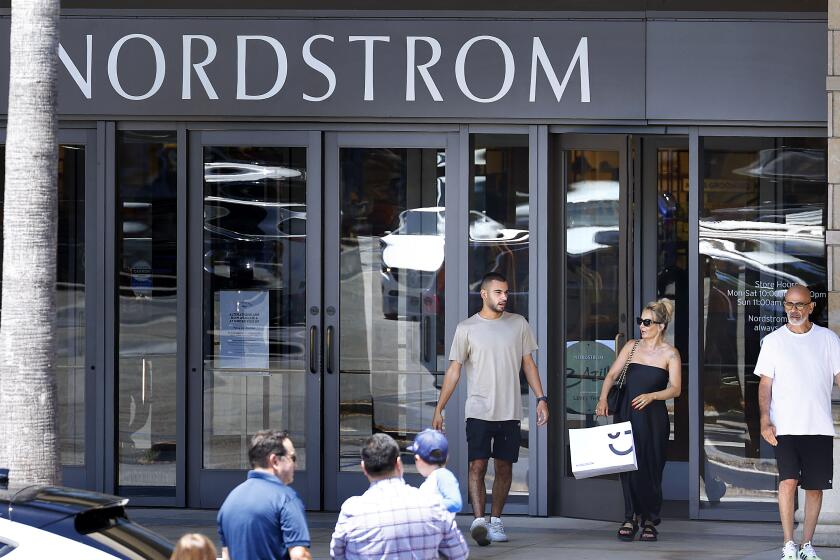Wall St.’s pain is acute for New Yorkers
- Share via
NEW YORK — At a black-tie gala to help poor kids, a woman had champagne splashed on her Oscar de la Renta gown. A week ago she might not have cared that champagne stains.
But last week was not a time to ruin an $8,000 dress.
The merry-go-round on Wall Street is spinning off even the wealthiest of riders. First the venerable Lehman Bros. Holdings Inc. and Merrill Lynch & Co. were upended; then taxpayers rescued the insurance behemoth American International Group Inc. to the tune of $85 billion.
The market collapsed and recovered, and subway commuters tried to hold steady as they read the headlines. “Worst Crisis Since 1930s, With No End in Sight,” the Wall Street Journal bellowed Thursday. And that was on Page 8.
Has Wall Street shaken this city before? Yes, many times, and once again, New Yorkers feared another avalanche.
There were reports of people canceling $600-a-month garage spaces to face the agony of parking on Manhattan streets this winter. In Greenwich, Conn., an investment banker haven, rules against posting for-sale signs were questioned.
“After this week,” sniffed one matron, “all of Greenwich may end up on EBay.”
Society columnist David Patrick Columbia witnessed the unfortunate champagne spill, which ruined Muffie Potter Aston’s designer dress. He also saw her react graciously.
“She had to be philosophical,” Columbia wrote on New YorkSocialDiary.com.
And so was he.
“We’ve been living a fantasy in New York -- with people paying $2 million for 2 bedrooms, buying expensive houses and tearing them down to rebuild, leasing pricey cars, sending three and four children for $30,000 each to private school. No one thought a moment about it,” Columbia said.
Until last week. Economic crises permeate America, but they often affect New Yorkers more deeply because it has deep ties to the financial sector.
Last week, Jack, a popular Greenwich Village bistro, added the “Dow Depression Special” to its menu. Every time the Dow Jones industrial average falls, dinner entrees will receive a cent-per-point discount. On Wednesday night the discount was $4.49 -- the Dow had tanked 449 points.
Jobs in the financial sector represent about one-fourth of the city’s personal income and roughly the same percentage of its tax revenues. The conventional wisdom is that every job on Wall Street creates two to four others -- for waiters and livery car drivers, store clerks and computer consultants.
Since the start of the year, New York’s muscular financial sector has weakened in the face of the subprime mortgage crisis, the credit squeeze and the plummeting stock market.
The turmoil has cost 53,196 jobs in the city, according to employment consulting firm Challenger Gray & Christmas. But those numbers don’t show up in the official state reports, said the firm’s director, John Challenger, because many people received severance and are still on payroll but out of work.
On Monday, Gov. David Paterson predicted the banking implosion would cost the state $1 billion in tax revenues over the next three years. A few days later two officials told the Associated Press the crisis would gouge the already red-inked state budget by $3 billion and swallow an additional 40,000 jobs.
Until recently, it looked like the city’s economy was holding its own. An influx of foreign tourists this summer made the city feel flush. Taking advantage of the weak dollar, euro- and pound-spending shoppers could be seen weighed down by packages -- and they weren’t just buying jeans. Foreigners represent about 8% to 12% of the real estate transactions in the last year, said Steve Spinola, president of the Real Estate Board of New York.
And there is no surer barometer of the health of this city than real estate. Wall Street bonuses in January are the mother’s milk of expensive real estate all year long. The Manhattan housing market has had some fat years recently, with prices up 18% between August 2007 and last month. An average Manhattan condo goes for $1.8 million; the average co-op is $1.2 million.
But there have been indications of trouble: The number of residential transactions in New York is down 28% in the last 12 months, Spinola said.
At the start of last week, Michael Goldenberg, who manages 150 brokers out of Halstead Property on the Upper West Side, was cool and professional. He has been a player in this type of docudrama in the past, he said.
“The stock crash in October ‘87, the Savings and Loan Resolution Trust scandal, the Latin American financial mess, the tech bubble, and now this,” Goldenberg said. “We face a financial crisis in this city every three to five years.”
Still, he wasn’t making any predictions. “If New York takes a real hit, is it unreasonable to think real estate won’t be unaffected?” he said.
“Listen, we’ve done well. We don’t want to see people suffer,” Goldenberg said, “but we always bounce back.”
Celeste LaRaja, 42, has been suffering. Nine months ago she was laid off from her $240,000-a-year job at Morgan Stanley.
To meet a $4,300 monthly payment on a one-bedroom she bought shortly before she was laid off, LaRaja has had to cut costs. She quit her gym, doesn’t take taxis or dine out, and took a bartending job.
LaRaja is still a stiff-upper-lip New Yorker: Lehman’s demise hasn’t deterred her from job hunting. She has an interview lined up with a hedge fund manager for a job as an assistant trader, a step down from her last job as a junior trader.
“It gives me New York, it gets me back into the business,” she said, and then interrupts her train of thought.
“You know, you always think it’s going to be so much fun to be a bartender. Let me tell you, it’s not.”
--
More to Read
Inside the business of entertainment
The Wide Shot brings you news, analysis and insights on everything from streaming wars to production — and what it all means for the future.
You may occasionally receive promotional content from the Los Angeles Times.










